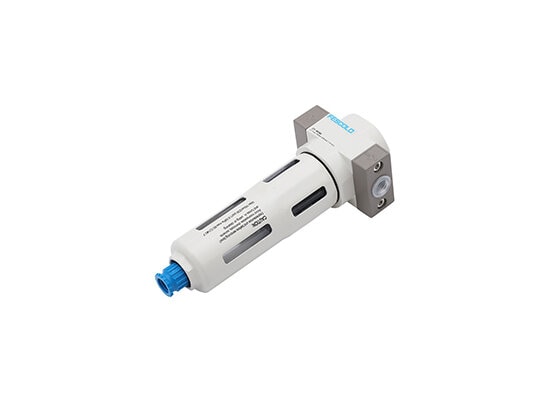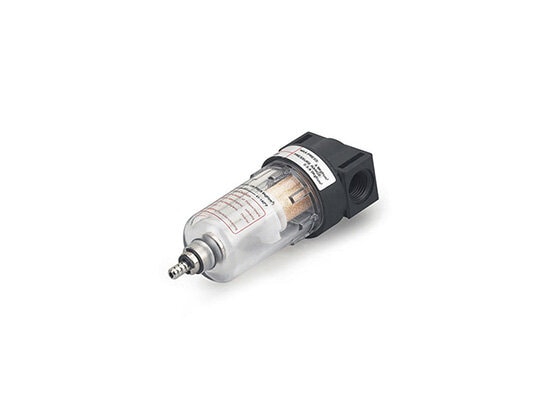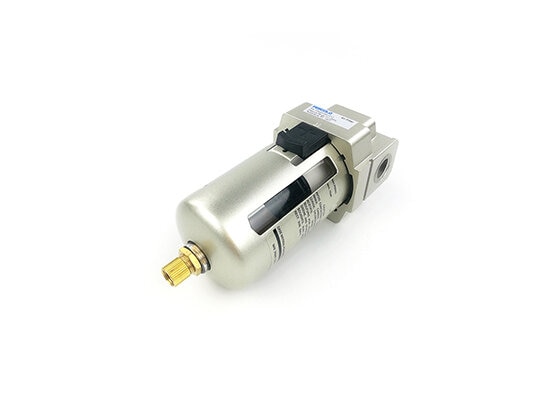Installed at the front end of the air preparation unit using mechanical filtration; employs refrigerated or adsorption drying methods and is installed after the filter.
Oct 17, 2025
In pneumatic systems, air filters and air dryers are typical air supply treatment components and form an important part of the pneumatic preparation components. Their main function is to treat the compressed air entering the system; however, each focuses on a different aspect of the treatment process.
The air filter is the filtering component in the FRL unit (filter–regulator–lubricator assembly), while the air dryer, which is also a common pneumatic component, can be either built inside the air compressor or installed as an independent external device.In addition, other air preparation components include air receivers (storage tanks), safety valves, drain valves, and similar auxiliary parts used to ensure stable and clean compressed air supply.
The biggest function of the air dryer is to remove moisture from the compressed air. Specifically, it stabilizes and cools the compressed air flow to minimize moisture, but it will cause pressure drop in the compressed air.
The pneumatic air filter is one of the three components in the FRL unit (Filter–Regulator–Lubricator) and is usually used as part of a combined assembly. Its main function is to remove particulate impurities and lubricating oil carried over from the air compressor in the compressed air. It also serves as the first air supply treatment component in the FRL system.
choose fokca pneumatic air filter online
Of series air filter: Removes larger particles, water droplets, and oil mist;

Af series air filter:Used for general air source treatment units that handle common impurities;

Bf series air filter:Removes fine particles and oil mist from compressed air.

Filter Housing: The outer shell used to support and protect the internal structure, typically made of aluminum alloy or high-strength plastic.
Filter Element: The core component responsible for removing solid particles and liquid impurities from the compressed air, commonly made of sintered bronze, stainless steel mesh, or fiber material.
Baffle / Deflector: Changes the direction of airflow and separates larger water droplets and oil mist through centrifugal force.
Drain Valve: Automatically or manually discharges the condensate and impurities collected at the bottom of the filter.
Protective Cover: Provides safety protection and allows easy observation of the condensate level.
Heat Exchanger: Cools the compressed air to condense the moisture within it.
Refrigeration Compressor: Provides the cooling power for the system.
Separator: Separates the condensed water from the cooled air.
Automatic Drain Valve: Periodically discharges the collected condensate.
Control System: Monitors parameters such as temperature and pressure to ensure stable operation.
Twin Towers (Adsorption Columns): Filled with desiccant material to absorb moisture from the compressed air.
Switching Valves: Control the airflow between the two towers, enabling alternating adsorption and regeneration cycles.
Regeneration System: Uses a portion of dry air to regenerate the desiccant material.
Controller: Manages the operating cycles to ensure continuous drying performance.
The air filter operates using mechanical filtration and centrifugal separation.
Through the action of baffles or deflectors, a swirling airflow is generated to remove impurities and liquid particles from the compressed air.
The filter element captures and collects the remaining contaminants, and finally, the drain valve discharges the accumulated water and impurities.
The air dryer works by lowering the air dew point or adsorbing moisture to remove water vapor from compressed air.
Refrigerated Drying: Uses a refrigeration system to cool the compressed air, causing water vapor to condense into liquid water, which is then removed through a separator and drain valve.
Desiccant Drying: Uses desiccant material to absorb moisture from the air, and the desiccant is regenerated through a regeneration process to enable continuous drying.
Air dryers and pneumatic air filters are both air source preparation components. They each process compressed air in different ways. Other components include pressure reducing valves, lubricators, oil-water separators, air storage tanks, safety valves, and drain valves.
The Air Filter is mainly used to ensure air cleanliness and extend the service life of pneumatic components, while the Air Dryer is primarily designed to ensure air dryness and prevent the system from moisture or rust. The two pneumatic components differ in structure, function, and installation position within the system. Working together, they ensure high air quality, efficient operation, and longer service life of the pneumatic system.
The air source processing component is the first and very important step in the operation of the entire pneumatic system.
You May Interest In
Links: www.fescolo.com(Pneumatic)
FOKCA ©1998-2025 All Rights Reserved Sitemap